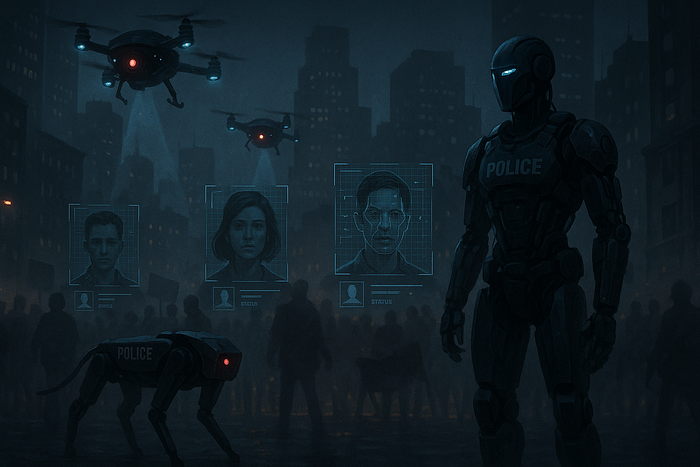🧠 Policing the Future: How AI, Robots, and Surveillance Tech Threaten Civil Liberties
The rise of high-tech policing tools like facial recognition, drones, and predictive AI promises safer streets—but are we building the infrastructure for tyranny?
⚡️ Introduction
In 1984, George Orwell warned us of a world where the government sees all, controls all, and punishes dissent before it begins. That future may be closer than we think.
Artificial intelligence, autonomous drones, facial recognition, and real-time surveillance are transforming how police operate across the globe. While these technologies promise more effective policing, they also carry profound risks: increased surveillance, reduced accountability, and the potential weaponization of law enforcement against the public.
This article explores how emerging technologies are reshaping the future of policing—and why society must tread carefully.
🤖 The Age of Predictive Policing: Palantir and the Power of Data
One of the most influential players in high-tech policing is Palantir Technologies.
Palantir's software platforms—Gotham, Foundry, and the Artificial Intelligence Platform (AIP)—analyze massive datasets, from healthcare records to license plate scans, to create predictive policing models. Law enforcement agencies, from local departments to U.S. Immigration and Customs Enforcement (ICE), use these tools to make decisions about who to monitor or arrest.
Critics argue that such systems replicate and amplify existing biases, all while operating in near-total secrecy. When software flags someone as a potential threat, how do they appeal? Who checks the algorithm?
> "If you want a picture of the future, imagine a boot stamping on a human face—forever." — George Orwell, 1984
🐕🦺 From Robo-Dogs to Android Enforcers: The New Police Force
Companies in both the U.S. and China are racing to build robotic law enforcers.
Boston Dynamics created the famous robot dog "Spot," which has already been tested by U.S. police departments.
Agility Robotics is developing humanoid bots for warehouse and logistics work—but such platforms can be adapted for patrol or riot control.
In China, Unitree Robotics is producing agile, affordable robotic dogs that could soon patrol streets, enforce lockdowns, or surveil protests.
These machines are fast, strong, tireless—and unlike humans, they don't question authority. As governments scale up robotic deployments, the fear is not whether they can stop a criminal, but what happens when they're used to stop a protest.
🥽 Augmented Eyes: Facial Recognition and AR Headsets
Police officers in several countries are testing smart glasses equipped with real-time facial recognition software.
U.S. company Vuzix is developing AR headsets that allow officers to scan and identify individuals as they walk past, pulling up records, biometric data, and risk assessments instantly.
Facial recognition itself is already controversial, with studies showing disproportionate error rates for people of color. Now, imagine that tech worn on a cop's face, scanning everyone in a crowd during a protest or public gathering.
Bernard Marr writes that while AR/VR may assist in training and tactical operations, it also risks turning every officer into a walking surveillance hub.
🗂 The Surveillance State: Data Hoarding and Super Databases
Modern policing isn't just about boots on the ground—it's about bytes in the cloud.
Law enforcement agencies across the globe are amassing vast amounts of personal data. In the UK, the Home Office's Data Services & Analytics unit was recently revealed to hold records on 650 million individuals, including children and asylum seekers—far more than the nation's population. Critics warn that these systems are unaccountable and opaque.
WIRED reported that this "super-database" could eventually include data from immigration records, medical files, and even school behavior reports—raising alarm bells over surveillance creep and digital profiling.
⚖️ Security vs. Freedom: The Slippery Slope to Tyranny
There's no doubt these technologies can enhance policing—especially in emergencies, hostage situations, and terrorist threats. But the danger lies in their misuse.
Technological infrastructure doesn't disappear once installed. Governments can (and do) repurpose tools meant for safety into instruments of repression.
Facial recognition used to track suspects can also be used to monitor political dissidents. AI algorithms designed to predict crimes can be trained to suppress protests. Robot dogs can be deployed not just in bomb threats—but in civil unrest.
If left unchecked, we risk entering a world where freedom is traded for efficiency, and dissent is algorithmically erased.
> "Until they became conscious they will never rebel, and until after they have rebelled they cannot become conscious." — George Orwell, 1984
🧭 Conclusion: Choose the Future Wisely
We stand at a crossroads. The technologies we build today will shape the society we live in tomorrow.
Law enforcement agencies must operate with transparency, independent oversight, and a commitment to civil rights. The public must demand clear policies, data protections, and legal accountability—before it's too late.
Because once the boot is on your face, it's hard to code your way out of it.
📚 Resources
Palantir Technologies and Predictive Policing The Daily Beast – "The Most Terrifying Company in America Is Probably One You've Never Heard Of" https://www.thedailybeast.com/the-most-terrifying-company-in-america-is-probably-one-youve-never-heard-of
Robotics in China and the U.S. The Washington Post – "China's robot dog revolution is going viral. What's behind it?" https://www.washingtonpost.com/world/2025/03/29/china-unitree-ai-robotics-revolution/
Smart Glasses for Law Enforcement Vuzix Blog – "Smart Glasses and the Future of Law Enforcement" https://www.vuzix.com/blogs/vuzix-blog/smart-glasses-and-the-future-of-law-enforcement
AR and VR in Policing and Military Use Bernard Marr – "How Augmented & Virtual Reality Is Used In Law Enforcement And The Military" https://bernardmarr.com/how-augmented-virtual-reality-is-used-in-law-enforcement-and-the-military/
Mass Data Collection and Privacy Concerns WIRED – "Inside the UK Government's Immigration Data Machine" https://www.wired.com/story/home-office-immigration-data/

